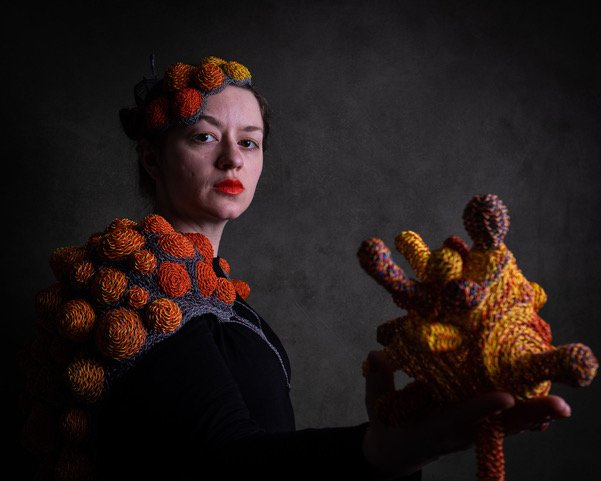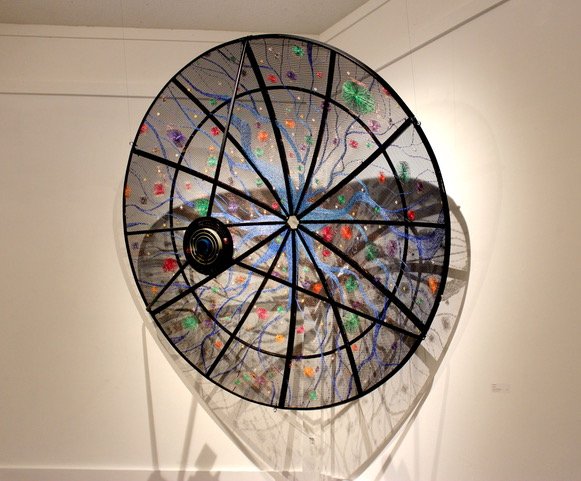Weaving Together // Reflections on Weaving Sustainability and Artistic Practice // Twyla Exner
Headshot, 2020
Post-Consumer Telecommunication Cables as wearable artwork
“Weaving Sustainability” is a series of events and activities that shine a light on fibre-based arts actions and practices that demonstrate environmental accountability and sustainability. These ideas are brought forth through the imagination and hard-work of the Cool Arts Society, Alternator Centre for Contemporary Art and the Kelowna Art Gallery. As a part of this series, I have been asked to contribute my own thoughts on sustainability in relation to fiber-based art practices through an essay.
To approach this task, I’ve decided to speak from my own experiences; they are, after all, the ones with which I am most familiar. Although I have worked with the topic for over a decade within my artistic practice, I still find the articulation of “sustainability” overwhelming. Living in a time when objects are intended to fail as an inherent process of consumerism, sustainability often feels like a practice or an ideal that is always out of reach.
For my small part as an artist, I have focused on using the materials and imagery of discarded electronic technologies (e-waste) to imagine an alternative ending for our electronic companions through art and craft based practices and the investment of a great deal of labour. One thing has always led to another within the development of my work, thus “weaving” sustainability, figuratively and sometimes literally, is an overarching theme in my journey thus far.
I have been an artist for as long as I can remember and I have always loved transforming the things that are around me into something new. As a kid, socks with holes became Barbie clothes, toilette paper rolls constructed furniture, and bits of yarn formed friendship bracelets. I grew up with parents and grandparents who treated materials and things as precious: every elastic band, bread tag, and twist tie were organized and saved for an undefined future purpose.
As an adult, my art practice has evolved out of an interest in nature, a sense of conflict over contributing further objects and materials into a culture of “too much”, a sensibility to use what is around me, an innate desire to make, and a belief that investing energy and care into materials is deeply meaningful.
I am inspired by the wonders of nature and the idea of electronics gone awry. I am interested in natural and manufactured materials that structure our daily experiences, their formal and practical similarities, and the ways in which their transformation holds meaning and history. I believe that hand-made processes and the investment of labour in unwanted, abandoned, or ignored things brings meaning and attention to forms, objects and materials considered to be expendable. My artistic investigations propose hybrids of technological structures and living organisms. They take form as abandoned technologies that have sprouted with new life, clever artificialities that imitate nature, or biotechnological fixtures of the not-so-distant future.
Early in my artistic practice I wove willow branches into natural forms such as nests and pods which I installed in indoor environments. I was interested in bringing outside inside and worked with willow because it was reflective of my environment. Willow soon became limiting to my conceptual investigations and the physical forms that held my interest. One day I was gifted a telephone cable collected by a friend from a construction site. With hundreds of plastic-covered copper wires in a rainbow of colours, my artwork took on a new direction. At first, I welded metal structures and wrapped them in meters upon meters of wire. After lugging sculptures that weighed hundreds of pounds and breaking a bone in my hand I sought a more sustainable approach. I learned to weave with the material. Lightweight, structure-supportive and beautiful, weaving provided a method of artmaking that didn’t require special equipment, armatures, or a large studio.
Using telephone wire to weave has lead me down many interesting research paths: the history of electrification, recycling and waste journeys for electronic refuse, how neural networks and our bodies own electrical systems influence human understanding of electricity, manufacturing practice and politics, how electricians use colour coding, and historical and contemporary basketry methods (including those practiced by the Zulu people in South Africa who make renditions of their traditional baskets using telephone wire). I have experimented with loom weaving, crocheting, knitting, embroidery, and basketry methods before settling on a braiding technique which allows me to freeform my artworks.
This research as well as an intuitive response to other collected e-waste materials has influenced the many directions my practice has taken.
I moved to Montreal, Quebec to attend graduate school in 2006 and at that time a lot of people were getting rid of their big desktop computer monitors in favour of thin monitors. People would put these monitors on the street for garbage pick-up. I grew up in Regina, Saskatchewan at a time when garbage was always in dumpster in your alley. I was jazzed to see peoples garbage and I soon developed deep empathy for these discarded computers. After all the material investments, years of development, and human ingenuity that went into them – there they were on the street on trash day (I blame Disney’s Brave Little Toaster for this level of emotional investment in abandoned machines).
In Invasion, I collected discarded desktop computers to house my woven wire sculptures. Through the process of taking apart those computers, I became interested in the circuit boards inside. I saw the coding on the circuit boards as similar to the hieroglyphs of ancient Egypt. I learned about the purpose of each circuit board code then described that code into a hieroglyph translation program to get the corresponding hieroglyph. I used this research to create Transcend, a scroll that traces the storage and coding of information across centuries.
Through my research for Transcend, I learned about the Parthian Cell, an ancient battery dating back to 200 BCE (Parthian cells include a steel rod, copper tube, and wax stopper, power is generated by any acidic liquid). I wondered: ”how many of these might it take to operate an iPod”? Passage uses 300 ancient batteries to power a 1st generation iPod shuffle. The iPod plays a recording of the sounds of making the batteries, layered to a pop beat and underscoring technologies relentless self-perpetuation. After collecting and dismantling computers for Invasion, I was left with circuit boards which I transformed into Memorial, a temporary public obelisk sculpture situated in downtown Montreal.
Spending time with abandoned circuit boards inspired imaginings about what circuits might do if liberated from their chips. Post-Desktop is a soft-sculpture installation of much larger than life circuits exploring interior space and interacting with one another. A return to working with woven wire after creating Post-Desktop saw the artwork take on more playful and creature-like forms and spawned an ongoing series of sculptures simply titled Things.
After dipping my body in the ocean for the very first time at the age of 30 and continuing on the tangent of technology and nature, a series of drawings, Adaptations, emerged. Adaptations imposes sea creatures and technological structures upon one another. Through this exploration, barnacles became a central figure for occupying the dish of satellites.
I found myself clinging to the idea of barnacles and their similarities to satellites. They are both receptacles that leave behind a structure after completing their lifecycle. They are both filters. They both encrust the structures they inhabit. I set out to combine the two ideas and it is my hope to one day encrust a building with barnacle-covered satellites. Cling has yet to find a building to encrust but has been exhibited in galleries and public spaces.
Through the process of collecting satellite dishes for Cling, friends, neighbours, and strangers soon began to bring me old technologies that they couldn’t quite bring themselves to throw away. Thus I found myself in possession of multiple metal dish satellites measuring up to 12’ in height. These enormous satellite dishes were popular among rural residents in the 1970’s-80’s and were used to receive radio and cable television signals. You can still see them today occupying farmer’s properties and mountain acreages. They have large circular frames with a metal mesh covering the surface. I see them as essentially very large embroidery hoops, which lead me to my current project, Conversion.
Conversion, 2021
Satellite Dish, Post-Consumer Telecommunication Cables
Conversion is so named because the main function of a satellite dish is to convert microwave signals into electric signals that can be used by a computer, tv and other devices. In my rendition, the conversion is from an abandoned technology to an artwork that presents as spectacle and object of consideration engaging the topics of technology, gendered labour, and forms from nature.
The embroidered images reference roots, river systems, florals and fungi and are representative of the area I live in Northern British Columbia. These abstracted natural forms are re-interpreted in bright colours using post-consumer telecommunication cables as the embroidery medium. The embroidered images present as a topographical view, playing on the role of an-earth bound satellite dish and its communication to satellites situated in space.
Conversion considers the history of altered found objects or ready-mades through the process of transformation via labour as well as context. By using the discards of e-waste, Conversion engages in a dialogue around the inherent process of capitalism in relation to technological development and the material implications of that trajectory. The juxtaposition of mass produced and hand-made, new and old technology, natural and manufactured, fast and slow ask us to consider the history and future of our technologies and how they relate to nature and human interactions within our environment.
As a person who collects unwanted technologies through misguided empathy justified with the practice of artmaking, I continually ask myself: What if e-waste were given an opportunity to sprout, spawn, and spread?
These tangible objects once enabled our access to the intangible expanse of the Internet, connectivity to friends and family, and provided a gateway to the data that comprises our memories, observations and research. Are these moments, connections, and memories still somehow stored inside the wires and circuits that comprise our devices? How do these unseeable and unknowable histories contribute meaning to the materials that are left behind? What potential does electronic waste hold as a material for sustainable artistic production? How can the significance of their materiality and service be recognized and remembered through the process of art making? And finally, how do these practices and questions speak to sustainability?
What do you think?
Twyla Exner is a Canadian artist inspired by the wonders of nature and the idea of electronic technologies gone awry. She uses the materials and imagery of discarded electronic technologies as a departure towards wonderous and worrisome installations, sculptures and drawings that propose hybrids of technological structures and living organisms. Twyla currently resides as a visitor on the unceded traditional territory of the Lheidli T'enneh in the forest of north-central British Columbia.
This is the second annual Weaving Together series, which brings to the forefront sustainable fibre art practices. Engaging the community to demonstrate accountability to the environment, show a coming-together through a variety of activities: online chats, essays, videos, in person workshops, and hands on community weaving opportunities. For more information on Weaving Together, visit Cool Arts Society.


